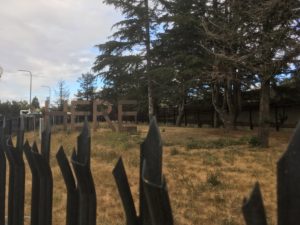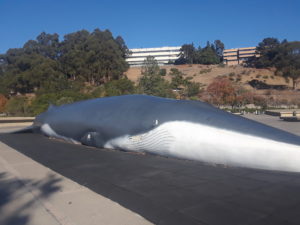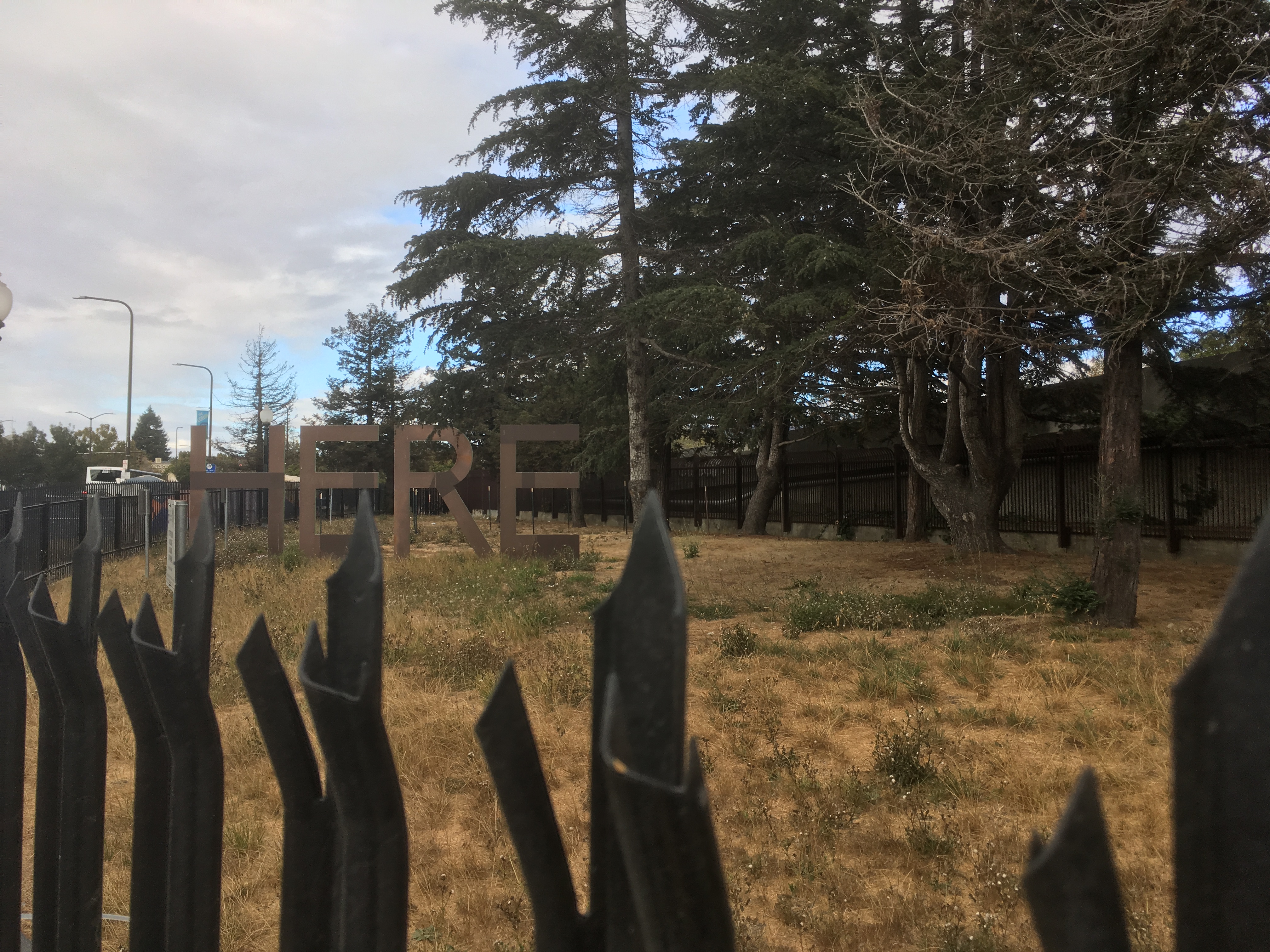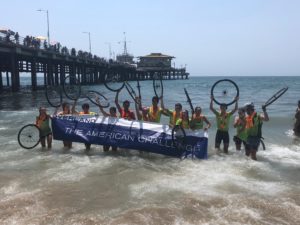Berkeley: a city across the bay from San Francisco, home of UC Berkeley, the Gourmet Ghetto, and chock full of quirky and memorable monuments. David Gales and Martin Mercy, both Berkeley natives, compiled a list of seven classic and fun Berkeley sites you should visit.
The HERETHERE Sculpture

photo by David Gales
Situated on both sides of the Berkeley/Oakland border, the industrially constructed, largely unadorned HERETHERE sculpture “serves as a whimsical and literary welcome to those entering Berkeley,” according to Berkeley’s Civic Art Program. The piece is intended to be a bold declaration of location, belonging, and unity. For most of my life, it was: surrounded by a small patch of green grass and trees, the sculpture stood proud between the two cities. Now, though, it is surrounded by a twisted iron fence, sharp to the touch. Around the fence are three homeless encampments. James Cartmill is a homelessveteran who works with Veterans for Peace, an organization that advocates for civil rights, political justice, and social reform. He lives in the homeless camp across the street from the HERETHERE sign. Two years ago, the camp surrounded the sculpture itself. “We were with the HERETHERE camp that was previously known as the ‘poor tour,’ and we started up the street by the Berkeley Food and Housing Project,” James describes, “We were chased around town. There were approximately fifteen raids… after Christmas, the camp came down here.” Cartmill pointed at the “THERE” portion of the sculpture, and gestured at the lawn.
The general story of the homeless camps at HERETHERE is well known to Berkeley residents. The camps themselves aren’t exactly hard to miss, especially since they were clustered around such an iconic modern landmark.
One day, the East Bay woke up to the new fence that blocked off the entirety of the sculpture. Signs dotted the black metal: “NO Trespassing,” “NO Camping,” “PROPERTY OF BAY AREA RAPID TRANSIT.” The fence had been a project several months in the making. Because the property is neither property of Berkeley nor Oakland, the cities themselves couldn’t do anything about the camps surrounding the sculpture. Left to its own devices, BART sent its police to evict the “First They Came for the Homeless” camp from around their sign on November 4, 2017, and commissioned the fence to be put up on November 5, a project that cost almost $200,000.
Dustin C, another resident of the current, nearby camp that was created as a result of the eviction, has said that there was no love lost between BART and the homeless groups nearby. “That money’s just a complete misuse of funds,” he says, “that would be like if you were starving and you decided to spend a million dollars on a piece of chocolate.” This sentiment is not restricted to the homeless people in the area, though. Oakland artist Steve Gillman, one of the two artists who created the original sculpture, described the fence as a “Trumpian move by BART.” BART themselves could not be reached for comment about the fence.
—DG
Moe’s Books
Four blocks away from UC Berkeley’s campus, and just down the block from People’s Park, a former political hotbed, Moe’s Books stands as a testament to Berkeleyan culture. Moe’s is Berkeley’s largest independent bookstore, a four-story mansion of knowledge, housing over 200,000 books for sale. Moe Moskowitz, a radical beatnik New Yorker, founded the bookstore in 1959 on Shattuck Ave. The bookstore moved to Telegraph Ave. in the 1960s and plunged into the heart of the anti-war movement rocking Berkeley at the time. People fill the massive store — most just browsing.
Says Doris Moskowitz, Moe’s daughter, “We try to have all of the best books. We don’t have all the books in the world, but we have a lot of titles because we sell used books. We have books that are out of print, or hard to find. We have books that have just been offered to us over the counter from all over the world. That’s what brings people back to Moe’s — the not knowing what you’re going to find when you come here. You have to come here to find out what’s here.” Personally, I practically grew up between the shelves. My favorite books can all be traced Moe’s, whether it be a manual on how to fix volkswagen buses from the 60s, a leather-bound Spanish bible filled to the brim with translated annotations, or a songbook of illustrated Beatles lyrics.
One can find anything at Moe’s — the police once even arrested Moe for refusing to toss “inappropriate” books, anachronistic zines containing nudity. Moe’s doesn’t just sell books, they work to make books available. The owners are sure to keep two fingers on the pulse at all times. Says Doris Moskowitz, “Berkeley has this world-class university, which is also a public university, so there are a lot of people looking for a good deal. A student who doesn’t have a lot of money needs to be able to buy the books that they need. That’s why we work so hard to keep our prices fair and reasonable.” If you want to find good books and great culture, head to Moe’s Books on Telegraph Ave.
—MM
Pheena the Whale

photo by Martin Mercy
I was probably only three or four the first time I saw the whale in the Berkeley hills. The Lawrence Berkeley Hall of Science, beloved by children all over the East Bay, is a towering building situated at the edge of a hill overlooking Berkeley. Pheena, an exact replica of a teenage female fin whale (the second largest species of whale in the world) lies outstretched in front of the museum. She is a grand total of 50 feet in length. Kids climb over her at all hours of the day, the younger ones struggling to clamber up her nose as older children walk along her back and crawl around her dorsal fin.
Pheena was brought to the Lawrence Hall in 1975. In 2016, she was restored after 40 years of sun damage and wear from small shoes and small hands. Pheena welcomes a visitor as they enter the museum grounds, and invites them to step up and admire the beautiful view across the Bay. On a clear day, you can see all the way from Pheena to the Pacific. On a foggy day, you can hardly see from Pheena’s nose to her tail. But no matter the weather, one thing remains the same: Pheena’s stoic, quiet, fiberglass resolve makes her the best whale I’ve ever seen in Berkeley.—DG
The Bear Fountain
The bear fountain in Berkeley is one of the lesser known icons of Berkeley. While the Camponeille is a more recognizable work of art, and the Greek Theater is architecturally iconic, the bear fountain holds a special place in Berkeley’s heart. Serving as a sort of bottom cap to the steep and perilous Marin Avenue (bike down it at your own risk!), the solid concrete fountain features several bears placidly looking out at passing cars from under streams of water.
There are many, many bear statues around Berkeley, and the fountain is one of the oldest. Originally built in 1911, it was completely destroyed by a truck barrelling down the hill in 1956. The fountain was not rebuilt until 1996. The Friends of the Fountain and Walk now meticulously maintains the fountain and surrounding walkways. In the summer, children and adults alike will cavort about and splash in the fountain’s water, seeking a cool respite from the thoroughly moderate Berkeley heat. In the winter, the lights on the bears provide a warm, inviting greeting on gray evenings and dark nights.
Friends of the Fountain and Walk informed me that the sides of the fountain are made of 40 individual blocks of concrete, each weighing 440 pounds. That means that the sides alone weigh 17,600 pounds. It’s an effective deterrent for drivers coming down the hill, as they have to turn to avoid hitting the fountain in case they don’t see the stop sign. Nevertheless, according to Berkeleyside, Berkeley averages a crash a year at Marin Circle.
—DG
East Bay Vivarium
There’s a store in Berkeley that sells animals that, if you were

photo by David Gales
determined enough, could kill a man. Monitor lizards, tarantulas, poison dart frogs, and snapping turtles are just a few of the animals sold by the East Bay Vivarium. Nestled behind a parking lot, sandwiched between two buildings, and crammed into a warm, wood-lined space, the East Bay Vivarium is a cultural cornerstone of Northwest Berkeley. Only one block away from the chic, tourist-addled 4th street, the East Bay Vivarium has remained one of Berkeley’s most beloved stores for over 48 years. The attraction is known for its labyrinthine, compact layout and its diverse and exotic selection of animals, and many visitors come simply to look at the reptiles and admire them. “I came during feeding time one time,” says Ashley, a vivarium client of several years, “that was fun. They had handfuls of chicks and they threw them in the cage.” Feeding time has remained a popular event at the vivarium since I started going as a little kid. The crowds have gotten larger and larger.
Oftentimes, the left side of the store, which houses the larger monitor lizards and snakes, attracts more attention from visitors. “The bigger reptiles, for me, are more worthwhile to look at,” said Dominic, a first time visitor at the store. Many of the monitor lizards have affectionate names, like Dot. The names are taped onto the glass of the terrariums.
Not everyone goes to the store to sightsee, though. As I wandered the various aisles, I saw a member of the staff ushering a pair of scorpions into a small plastic container using a block of wood. The pair of arachnids snapped at each other viciously, yet the staff member all but ignored the fight going on next to his fingers. The customer who had requested them squatted next to him, and the two chatted casually about the customer’s close encounter with an even deadlier species of scorpion, one dangerous enough to kill a full grown horse. The staff member laughed nonchalantly: “Yup, they’ll do that to ya.”
Whether you’re going to admire the large lizards or the spectacular scorpions, the twitchy tarantulas or terrific turtles, the East Bay Vivarium is a must-see stop in Northwest Berkeley.
—DG
The Orb
Not much is known about the orb. The mysterious metal ball stands 6.5 feet and guards the southern entrance of campus, beside the

photo by Martin Mercy
“University of Berkeley, California” sign. The bronze sphere has a broken exterior, sculpted to look crumbly and cracked, and a cylinder cut through the side to create a napkin-ring shape. From the front, you can see through the orb to see the middle of the hollow core. Sarah, a UC Berkeley student, expressed that she “wish[ed] there was more information about it, because I don’t really know much about it, or why it is there. It seems interesting — it’s a very cool piece of art, but if it’s going to be on campus, it should have a plaque. I wish it was more in the center of campus. I feel like I’m not the only one on campus who has no idea why this sphere is here, or why it’s there.”
To be absolutely honest, even I didn’t know why the Orb was there until we researched it for the article. Italian artist Arnaldo Pomodoro sculpted the “Rotante Dal Foro Centrale,” or “Rotating from the Central Hole” as part of his collection, “Sfera con Sfera,” or “Sphere within Sphere.” The collection is displayed all over the world, with sculptures as close as San Francisco’s de Young Museum and as far as the Vatican Museums in Rome. Berkeleyans are familiar with their Pomodoro Sphere. As a child, I crawled through it, and I still see it every day on my way home. However, robots recently took the site captive. Kiwi, an automatized campus delivery service parks all of their distribution robots in front of the sculpture, barring tourists and students from taking photos with the sphere without having a background product placement. Sarah, the Berkeley student, observes, “All of the Kiwis are always crowding around [the orb], and I’m really not a fan of the kiwis.” Although the metal ball seems strange and mysterious, Berkeley wouldn’t be Berkeley without it.
—MM
Cheese Board
Everyone in Berkeley knows the Cheese Board Collective; The building is impossible to miss with its iconic address number made of bread. The front door is clouded by the out-the-door line. On any given day, there will be a line stretching out from Cheese Board’s register and around the corner. For lunch and dinner, Cheese Board has live band performances. In the morning they sell some of the cheapest, best coffee in Berkeley.
The Cheese Board is also one of Berkeley’s oldest co-ops. The small cheese store was sold to the employees in 1971 and has been worker owned ever since. Ursula Schulz, a member of the co-op, says, “I love that it’s a worker owned co-op. Everyone has one vote, and everybody makes the same wage. We have great worker retention because of that, and a deep depth of knowledge because owner-employees stay around. Also, cheese and bread and pizza…what’s not to like?” I often go to the Cheese Board — it suits any meal, whether it be sweet pastries for breakfast, fancy cheese and fresh bread for lunch, or piping hot pizza for dinner. They have a wide selection of delicacies, with a pantry of over 400 cheeses, and a new type of sourdough pizza every single day. Despite their quality and variety, Cheese Board still manages to keep affordable prices; they’re cheaper than Papa John’s. The Cheese Board is so successful that they’ve repeated their structure: they helped found and fund the Arizmendi’s bakeries in Oakland and SF, each of which is a co-op. If you want to chat with the Berkeley community and enjoy the best pizza you’ve ever had, stop by the Cheese Board.
—MM
Cowritten by David Gales






